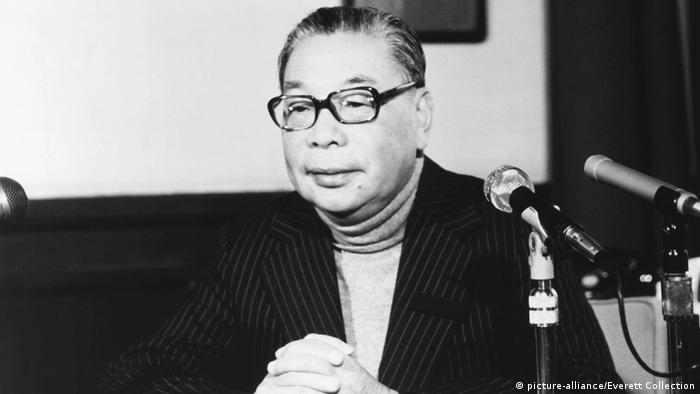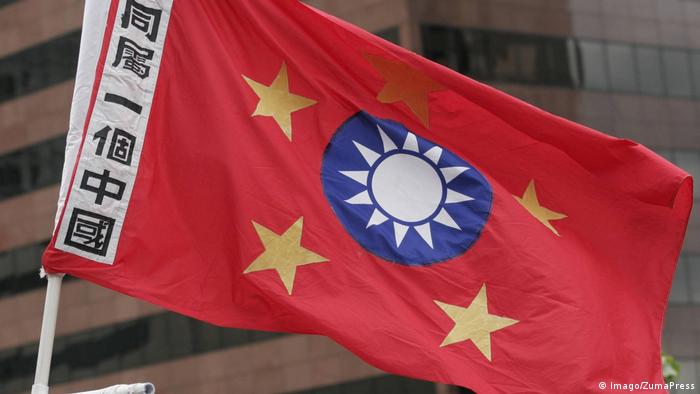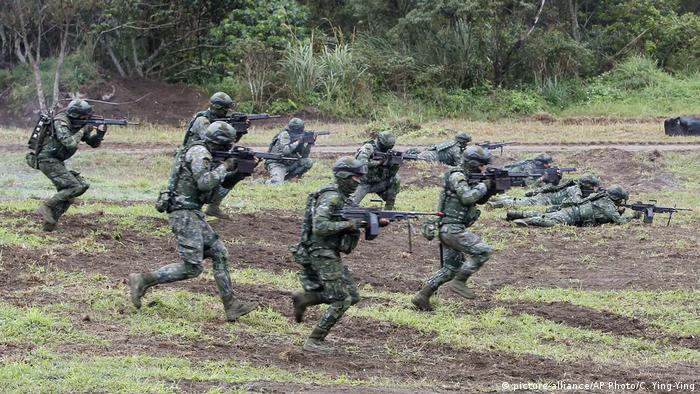Taiwan prepares to hold large-scale military drills to deter China
Amid heightened tensions in cross-strait relations, Taiwan’s military is starting a series of newly designed large-scale military drills. Taiwanese analysts say the island should enhance its combat preparedness.

Taiwan’s armed forces are on Thursday holding their first live-fire drill for this year, an exercise aimed at improving their military readiness. It comes after Chinese President Xi Jinping recently reasserted Beijing’s right to use force to unify the self-governing island with mainland China. Thursday’s drill is part of the large-scale military exercises designed to counter the growing threat from China.
Even though Taiwan’s military holds such exercises regularly, this year’s training adopts new tactics aimed at “defending against a possible Chinese invasion,” said Major General Yeh Kuo-hui, the Taiwanese defense ministry’s planning chief.
Read more: How powerful is China’s military?
According to Taiwan’s Central News Agency (CNA), the military drills are divided into four components. A month of combat readiness training is to be held in the first quarter, followed by the month-long Han Kuang live-fire exercise in the second quarter and joint anti-landing operations in the third quarter. In the fourth quarter, the military plans to hold joint anti-airborne exercises.
Taiwan’s defense ministry has stressed that the exercises are not a direct response to Xi’s recent speech, pointing out that planning for the drills began as early as mid-2018. But experts say threats coming from Beijing must have played a major role in Taipei’s decision to expand the scope of the drills. China’s ongoing military modernization and improving capabilities have been a source of concern for Taiwan.
 The drills come after Chinese President Xi Jinping recently reasserted Beijing’s right to use force to unify the self-governing island with mainland China
The drills come after Chinese President Xi Jinping recently reasserted Beijing’s right to use force to unify the self-governing island with mainland China
China enjoys an overwhelming military edge over Taiwan, with Beijing boasting the world’s second-biggest defense budget, estimated at over $170 billion (€149.2 billion), and over 2.5 million strong military.
“It is in Taiwan’s interests to have as advanced and capable a military as possible to protect its future and political self-determination,” said David An, a senior research fellow at the Global Taiwan Institute. “[Since] China has advanced [its military capabilities] so much in the past several decades, we can’t say there is a cross-strait [military] balance today.”
Credible deterrence
The situation has prompted Taiwan to alter its military strategy. While the island previously focused on defending itself from a Chinese landing force, its focus now has expanded to repelling an invasion on sea and in the air.
Read more: Taiwan rejects China’s ‘reunification’ proposal
Andrew Yang, a former defense minister of Taiwan, told DW that the shift represents Taiwan’s adoption of multilayer deterrence, and that the live-fire drills offer a chance for Taiwan’s military to demonstrate how they would execute their strategies during wartime.
“Even though Taiwan’s current military capability is not able to fully execute the new strategies, this year’s broadened plan shows that our military is working towards that goal,” Yang noted.
Ian Easton, an expert on cross-strait defense issues at Project 2049 Institute, an American think tank, argued that it’s crucial for Taiwan to develop credible deterrence to keep potential Chinese invasion forces from getting close to its territory.
“It’s always much better to strike an invading enemy at the greatest possible distance,” Easton told DW. “Taiwan’s military strategists will naturally seek to expand the battle space and [developing the ability to do so] is critical for deterrence and crisis management.”

Recapturing vs. liberation
After the end of WWII, the Communist Party of China (CPC) under Mao Zedong pursued a fierce battle against his archrival Chiang Kai-shek, chief of the Kuomintang (KMT) party. Chiang lost and took refuge in the island of Taiwan. For some time after that, Taiwan was the center of propaganda from both sides. The CPC wanted to “liberate” Taiwan, while Kuomintang wanted to “recapture the mainland.”

Letters to ‘compatriots’
In the 1950s, the CPC published four “Messages to Chinese compatriots” in Taiwan, which are considered the basis of Beijing’s Taiwan policy. In these texts, Beijing warned Taiwan of collaborating with US “imperialists.” Military confrontation, particularly artillery attacks, also continued during this time.

Beijing replaces Taipei in UN bodies
In 1971, the United Nations General Assembly declared that the People’s Republic of China was the sole lawful representative of the country. With this decision, the Republic of China (ROC)/Taiwan was removed from all UN bodies. The frustration of ROC’s foreign minister, Chow Shu-kai (right), and his ambassador Liu Chieh is easy to see in this picture.

New Taiwan policy
The fifth and last “message” from Beijing to Taiwan was published on January 1, 1979. The mainland, under the leadership of the reformist Deng Xiaoping ended military operations, announced the development of bilateral ties and promised peaceful reunification. However, Beijing’s right to represent China internationally was not to be questioned.

‘One China’ policy
The new orientation of China’s Taiwan policy took place as Washington and Beijing got closer. On January 1, 1979, the US and China resumed diplomatic relations, with Washington under President Jimmy Carter recognizing Beijing as the sole legitimate government of the whole of China. The US embassy in Taiwan was remodeled into an institute for culture.

‘One China, two systems’
Even before meeting US President Carter, Deng Xiaoping had introduced the principle of “one country, two systems,” which allowed Taiwan to maintain its social systems even after reunification. However, Taiwan’s President Chiang Ching-Kuo did not immediately fall for it. On the contrary, in 1987 he formulated the principle of “one China for the better system.”

The independence movement
In 1986, the Democratic Progressive Party (DPP), Taiwan’s first opposition party, was founded. At a meeting in 1991, the DPP declared a clause for Taiwan’s independence, which stipulated that Taiwan was sovereign and not a part of China.

‘Consensus of 1992’
In unofficial Hong Kong talks in 1992, representatives of Taipei and Beijing reached a political agreement on the nature of their relationship. Both parties agreed that there was only one China. However, they had different views on what “One China” meant. A year later, the chief negotiators Wang (left) and Koo met in Singapore.

Bilateral relations
In an interview with DW in 1995, the first democratically elected President of Taiwan and the KMT leader Lee Teng-hui said that all relations beyond the straits of Taiwan would be “defined as relations between states; at the very least, as a relationship of a special kind between states.” His formulation was very close to being a declaration of independence.

‘A state on every side’
The DPP won the presidential election for the first time in 2000, with Chen Shui-bian, the Taiwanese-born who had no connections to mainland China, calling for “a state on each side.” It meant that Taiwan should have nothing to do with China anymore. In 2005, Beijing reacted with the Anti-Secession Law, which allowed the use of military force in the event that Taiwan declared independence.

‘One China, different interpretations’
After losing the elections in 2000, the KMT adopted a changed formulation of the “Consensus of 1992” in the party’s statute, which called for “one China, different interpretations.” That is why the 1992 Consensus is still debated in Taiwan. The reason: the negotiators of 1992 did not have an official position.

CPC meets KMT
The mainland adopted the “Consensus of 1992” as a political basis for creating a relationship with Taiwan. In the first summit between the two sides since the communists came to power in China, Hu Jintao (right) and Lian Zhan endorsed the “Consensus of 1992” and the “One China” principle.

‘The direction is correct’
After KMT’s Ma Ying-Jeou won the 2008 presidential elections, both sides continued to come closer. In an interview with DW in 2009, Ma said: “The straits of Taiwan should be a place of peace and security. We have come a lot closer to this goal. Basically our direction is correct.”

Quo vadis?
After the elections in 2016, when President Tsai Ing-wen came to power, the independence movement gained a lot of wind. Tsai disputed the existence of the 1992 consensus and described the “attempt of China to interfere in the political and social development of Taiwan” as the “biggest challenge.”
Upgrading fighter jets
Apart from the scheduled military exercises, Taiwan is also planning to spend about $3.64 billion to upgrade its existing 144 F-16 A/B fighter jets, and it is expected to receive four of them later this year. According to CNA, the converted fighter jets will have capabilities that are equivalent to the higher end F-16Vs. While talks are also being held about acquiring the advanced F-35 fighter jet, experts believe it is more practical for Taiwan to replace the island’s two-decade-old Mirage 2000 jets with the upgraded F-16 fighter jets because the F-35 is both expensive and difficult to train the pilots on.
“Acquiring new F-16 aircraft makes sense in the near term,” Easton said. “Taiwan could invest in a larger fleet of land attack cruise missiles, attack drones and cyber weapons to respond to China’s ballistic missile threat.”
So far, Taiwan’s defense ministry has confirmed the upgrade of the F-16 fighter jets. It has also not ruled out purchasing the F-35 fighter jets. The ministry spokesperson Chen Chung-chi told DW that while upgrading F-16 fighters is the priority, they are also considering the acquisition of other advanced planes. “As long as the fighter jets can fulfill Taiwan’s need to defend its airspace, we will consider acquiring them,” said Chen.
 China’s ongoing military modernization and improving capabilities have been a source of concern for Taiwan
China’s ongoing military modernization and improving capabilities have been a source of concern for Taiwan
Restarting the military conscription debate
Analysts say one of the key issues for Taiwan’s self-defense is keeping control of its territorial waters and airspace while ensuring Taiwan’s military can withstand China’s advanced firepower. Yang argues that Taiwan should put more emphasis on developing advanced missile capabilities and unmanned aerial vehicle (UAV) technology as these can satisfy Taipei’s needs to safeguard the island’s outer perimeters.
Additionally, he sees the need for Taiwan to restart the debate over military conscription, as voluntary enlistment, in his view, isn’t enough to sustain the size of Taiwan’s military.
“Judging from the result of voluntary enlistment, I think it’s time for the government to start a national debate about reviving compulsory enlistment,” Yang said.
 Even though Taiwan’s military holds such exercises regularly, this year’s training adopts new tactics
Even though Taiwan’s military holds such exercises regularly, this year’s training adopts new tactics
Can Taiwan count on US?
Apart from Taiwan’s own military upgrades, Washington’s level of involvement in a potential cross-strait military conflict will be key to determine its outcome, say observers.
Despite repeatedly promising to respond if China used force against Taiwan, Yang said, the US government has never clearly defined how it would respond. The expert is of the view that Taiwan cannot completely count on the US to come to the island’s defense. That’s why Taipei should focus on strengthening its defense capabilities, stressed Yang.
Easton, however, argues that based on past record, “the US would move toward a formal military alliance with Taiwan” if a major crisis broke out. “In peacetime, Washington tends to be extremely cautious,” Easton said. “It is far less constrained when a friendly democracy like Taiwan is taking enemy fire.”
DW RECOMMENDS
China’s Xi Jinping calls for ‘peaceful reunification’ with Taiwan
Xi Jinping has renewed calls to resolve the “Taiwan issue,” dismissing the notion of independence for Taiwan. Though advocating for a peaceful solution, Xi emphasized that China would not rule out the use of force. (02.01.2019)
Opinion: Xi’s Taiwan ‘unification’ speech a message to US
Chinese President Xi Jinping has pledged renewed efforts to resolve the “Taiwan issue.” Beijing will likely further ratchet up pressure on Taipei this year, DW’s Philipp Bilsky writes. (02.01.2019)
How powerful is China’s military?
With the second-largest defense spending in the world, measuring over $150 billion in 2017, China is rapidly modernizing the People’s Liberation Army (PLA) and could soon pose serious challenges to US military dominance. (09.05.2018)
Taiwan rejects China’s ‘reunification’ proposal
Chinese President Xi says he will “leave no room” for separatist activities, and that Beijing “reserves the option of taking all necessary means,” including the use of force, for the Taiwan “reunification.” (02.01.2019)